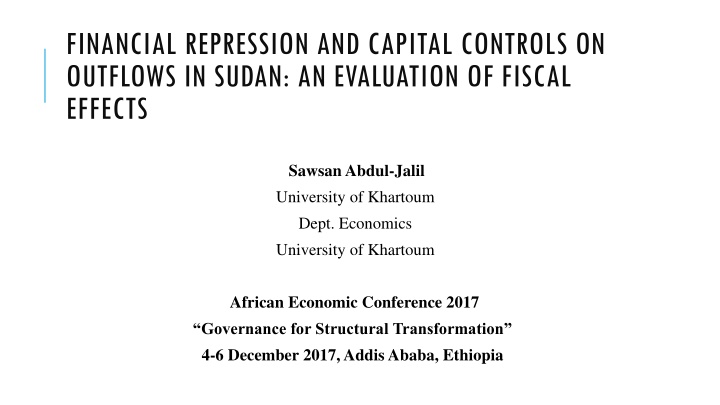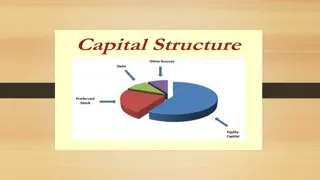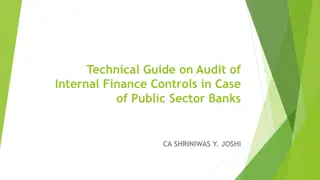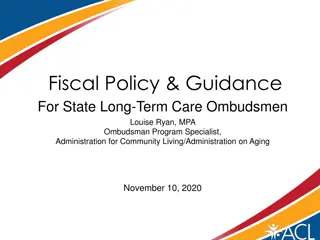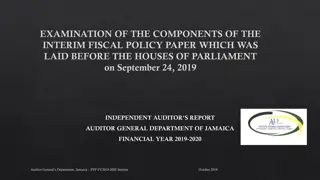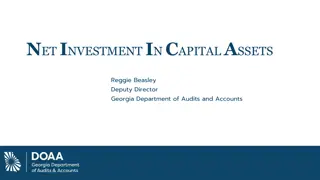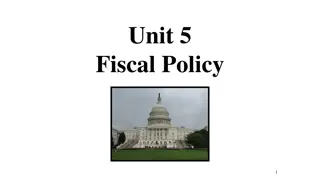Evaluation of Fiscal Effects of Financial Repression and Capital Controls in Sudan
This study evaluates the fiscal effects of financial repression and capital controls on outflows in Sudan, considering the impact on government revenue and borrowing costs. It examines the potential consequences of relaxing capital controls on the fiscal balance in the country.
Download Presentation

Please find below an Image/Link to download the presentation.
The content on the website is provided AS IS for your information and personal use only. It may not be sold, licensed, or shared on other websites without obtaining consent from the author.If you encounter any issues during the download, it is possible that the publisher has removed the file from their server.
You are allowed to download the files provided on this website for personal or commercial use, subject to the condition that they are used lawfully. All files are the property of their respective owners.
The content on the website is provided AS IS for your information and personal use only. It may not be sold, licensed, or shared on other websites without obtaining consent from the author.
E N D
Presentation Transcript
FINANCIAL REPRESSION AND CAPITAL CONTROLS ON OUTFLOWS IN SUDAN: AN EVALUATION OF FISCAL EFFECTS Sawsan Abdul-Jalil University of Khartoum Dept. Economics University of Khartoum African Economic Conference 2017 Governance for Structural Transformation 4-6 December 2017, Addis Ababa, Ethiopia
OUTLINE Introduction Methodology Main findings Limitations
INTRODUCTION: BACKGROUND Several empirical works found that capital controls on outflows have a positive fiscal effect, mainly through two channels: Allowing the government to reduce the cost of domestic borrowing Maximization of seigniorage Since the secession in 2011 and the loss of the critical oil revenues, Sudan has been struggling to improve its fiscal stance The IMF is advising the government to lift controls on capital outflows Would relaxing capital controls on outflow effect adversely the fiscal balance of the government?
ESTIMATION OF THE REVENUE FROM FINANCIAL REPRESSION (GIOVANNINI AND DE MELO, 1991) Giovannini & De Melo (1991) estimate the revenue generated by financial repression in presence of capital controls Their methodology is based on the idea that financial repression enables the government to borrow at a lower rate than the foreign rate Hence, The revenue from financial repression is the difference between foreign and domestic costs of borrowing
ESTIMATION OF THE REVENUE FROM FINANCIAL REPRESSION (GIOVANNINI AND DE MELO, 1991) ???????? ???????? ?? ???????? ???? (???) (???????? ???? ???????????? 1+???????? ???? ????????????)/2 ??= (1) ?? =???????? ???????? USD?+? ???? ?? ???????? ???????(USD)? (???? ??????????? USD? 1+???? ??????????? USD?)/2 (2) ??? ???? ???? ????????? = ? (??????? ???????????? ?? ???/ ??? ??? ???? ????)(3) ??) ???????? ???? ???????????? ??????? ???? ????????? ?????????? = (?? (4)
ESTIMATION OF THE REVENUE FROM FINANCIAL REPRESSION, DATA Due to data availability, only short-term debt was taken into consideration Data were sourced out of Sudan Company for Financial Services, World Bank-World Development Indicators, World Bank- International Debt statistics All data covers the period from 2000-2014
MAIN FINDINGS: NEGATIVE REVENUES FROM FINANCIAL REPRESSION Table : Financial repression revenue, in averages, Sudan, 2000-2014 Financial Interest rate differential Exchange rate component repression revenue as % of component As % per As a % of As % per As a % of GDP annum GDP annum GDP -0.8 -0.2 -0.8 0.0 0.0 Source: Author s computations
MAIN FINDINGS: WHY THE REVENUE FROM FINANCIAL REPRESSION IS NEGATIVE? 1. Exchange rate stability 2. High domestic cost of borrowing
MAIN FINDINGS: EXCHANGE RATE STABILITY Change in official exchange rate, SDG/USD, year average, in percent, Sudan, 2000-2014 Source: Based on WB (2016)
MAIN FINDINGS: HIGH DOMESTIC COST OF BORROWING Issuance of GMCs, in million USD, and GMC average annual yield (in percent), Sudan, 2000-2014 Years Issuance Profit-margin % 2000-2004 2063 25 2005-2009 3583 17 2010-2014 45035 18 SCFS. (2014)
LIMITATIONS Not accounting for Seigniorage Data availability
DETERMINANTS OF CAPITAL CONTROLS IN SUDAN Several studies found correlation between the imposition of capital controls and several structural country characteristics (Alesina, Grilli & Milesi-Ferretti, 1993; Aizenman & Guidotti, 1994; Milesi-Ferretti, 1998) Inefficient tax system Financially repressed sector These aspects were analyzed in the case of Sudan using several indicators such as: Tax/GDP, the tax structure, M2/GDP, reserve requirement, bank credit to bank deposit, domestic credit and reserve requirement.
MAIN FINDINGS: INEFFICIENCY OF THE TAX SYSTEM Graph: Tax/GDP, in percent, Sudan, 1970-2006 20 18 16 14 12 10 8 6 4 2 0 1970 1973 1976 1979 1982 1985 1988 1991 1994 1997 2000 2003 2006 Source: Based on Alamir (2007, p. 241)
FINANCIAL REPRESSION IN SUDAN Graph : M2/GDP, in percent, Sudan, 1965-2014 160 140 120 100 80 60 40 20 0 1965 1968 1971 1974 1977 1980 1983 1986 1989 1992 1995 1998 2001 2004 2007 2010 2013 Sudan Pakistan Egypt Malaysia Source: WB (2016)
EFFICIENCY OF THE TAX SYSTEM Table 1: Tax/ GDP, in percent, selected Sub-Saharan countries, 1990- 1995 Country Country/ years 1990 1991 1992 1993 1994 1995 average Angola Botswana Cameroon Ethiopia Ghana Ivory coast Kenya Senegal Sudan Uganda Period average excluding Sudan 22 40 10 10 11 18 20 16 5 7 15 37 10 8 12 17 20 17 6 6 25 37 10 8 10 17 20 15 7 7 37 33 8 11 13 15 25 14 6 8 39 29 10 13 17 16 25 12 7 9 28 27 11 12 15 18 26 14 7 10 28 34 10 10 13 17 23 15 6 8 16 15 16 17 18 17 16 Source: Based on Stosky & WoldeMariam (1997, p. 50-55)
